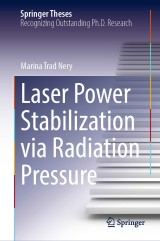Details

Laser Power Stabilization via Radiation Pressure
Springer Theses
|
160,49 € |
|
| Verlag: | Springer |
| Format: | |
| Veröffentl.: | 25.04.2022 |
| ISBN/EAN: | 9783030958688 |
| Sprache: | englisch |
| Anzahl Seiten: | 154 |
Dieses eBook enthält ein Wasserzeichen.
Beschreibungen
<div>This book offers a comprehensive and complete description of a new scheme to stabilize the power of a laser on a level needed for high precision metrology experiments. The novel aspect of the scheme is sensing power fluctuations via the radiation pressure driven motion they induce on a micro-oscillator mirror. It is shown that the proposed technique can result in higher signals for power fluctuations than what is achieved by a direct power detection, and also that it enables the generation of a strong bright squeezed beam. </div><div>The book starts with the basics of power stabilization and an overview on the current state of art. Then, detailed theoretical calculations are performed, and the advantages of the new scheme are highlighted. Finally, a proof-of-principle experiment is described and its results are analyzed in details. The success of the work presented here paves a way for achieving high power stability in future experiments and is of interest for high precisionmetrology experiments, like gravitational wave detectors, and optomechanical experiments.</div><div><br></div><div>Nominated as an outstanding PhD thesis by the Gravitational Wave International Committee.</div>
Introduction.- Sensing laser power fluctuations via an Alternative Observable of the Light Field.- Fundamental Limits of Power Stabilization via a Radiation Pressure Transfer Scheme.- Power Tabilization via Radiation Pressure - Experimental setup.- Power Stabilization via Radiation Pressure.- Experimental results Chapter 6.- Summary.
Marina Trad Nery graduated from the State University of Campinas, UNICAMP, with a Bachelor Degree in Physics. She worked on the field of cosmic rays and wrote a monography with title "Study of the capacity of the Pierre Auger Observatory in detecting a dipolar anisotropy", funded by FAPESP. During her master studies she worked with experimental optics, more specifically with optical parametric oscillators and with supercontinuum generation in PCF fibers. She received her Master Degree in Physics for the thesis "Construction of an optical parametric oscillator for trapping cold atoms", funded by the Scholarship of Productivity in Innovative Technological Development and Extension from CNPq. After her master studies, she worked as an Intellectual Property Analyst at the Innovation Agency of the State University of Campinas, Brazil. For her Ph.D. studies she moved to Germany and worked as a research associate at the Max-Planck-Institut für Gravitationsphysik (Albert-Einstein-Institut) andLeibniz Universität Hannover, with a fellowship from the Marie Curie International Training Network. She became a member of the LIGO collaboration and worked together with Professor Benno Willke on lasers for future Gravitational Wave Detectors. In 2020 she received her Doctoral of Natural Sciences Degree with the excellent mark “summa cum laude”. Her thesis was honored by the Prize of the Leibniz Universitätsgesellschaft e. V. and by the 2020 GWIC-Braccini Thesis prize. Since October 2020, she works as a researcher in the group “Advanced Light Sources” in the Cluster of Excellence “Quantum Frontiers”.
<p>This book offers a comprehensive and complete description of a new scheme to stabilize the power of a laser on a level needed for high precision metrology experiments. The novel aspect of the scheme is sensing power fluctuations via the radiation pressure driven motion they induce on a micro-oscillator mirror. It is shown that the proposed technique can result in higher signals for power fluctuations than what is achieved by a direct power detection, and also that it enables the generation of a strong bright squeezed beam.</p><p>The book starts with the basics of power stabilization and an overview on the current state of art. Then, detailed theoretical calculations are performed, and the advantages of the new scheme are highlighted. Finally, a proof-of-principle experiment is described and its results are analyzed in details. The success of the work presented here paves a way for achieving high power stability in future experiments and is of interest for high precision metrology experiments, like gravitational wave detectors, and optomechanical experiments.</p><p>Nominated as an outstanding PhD thesis by the Gravitational Wave International Committee.</p>
Nominated as an outstanding PhD thesis by the Gravitational Wave International Committee Provides a complete theoretical and experimental description of a new scheme for laser power stabilization Includes analysis of nondemolition schemes for power stabilization
Diese Produkte könnten Sie auch interessieren:

Femtosecond Optical Frequency Comb: Principle, Operation and Applications

von: Jun Ye, Steven T. Cundiff

149,79 €















